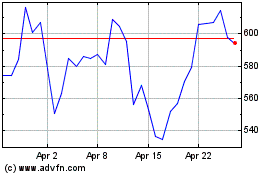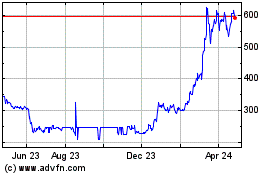Binance Secures Approval To Invest US Customer Fiat Funds In US T-Bills, BNB Price Surges
20 July 2024 - 11:30AM
NEWSBTC
Binance has received court approval allowing it to invest customer
fiat funds into US Treasury Bills (T-Bills) after a year of
heightened scrutiny of Binance’s operations in the United States.
The decision has resulted in a notable price recovery for the
exchange’s native token, Binance Coin (BNB), pushing it toward the
$600 level. Court Grants Relief To Binance BAM Subsidiary A
court filing reveals that BAM Trading Services and BAM Management
US Holdings, collectively known as BAM, filed a motion seeking
relief from a consent order. The court, upon consideration of the
motion, granted the requested relief. As a result, Binance’s
US subsidiary, BAM, is now authorized to hire third-party
investment advisors to manage corporate assets, paving the way for
BAM to invest client fiat funds in US Treasury Bills. Related
Reading: Market Strategist Says Bitcoin Downtrend Is Finally Over,
Here’s Where Price Is Headed Next Under the court-approved
arrangement, BAM can invest certain customer fiat funds, currently
held at BitGo, in US Treasury bills on a rolling four-week basis.
However, to ensure compliance, BAM is prohibited from involving any
third parties, including Binance Entities, in these
investments. Notably, BAM must maintain sufficient USD
liquidity on its platform to honor customer fiat withdrawal
requests during the investment period. Additionally, BAM is
required to amend its terms of use and provide appropriate notice
to customers, aligning with the authorized investment activities.
Compliance Journey Continues Interestingly, as part of the court’s
decision, BAM is now permitted to custody assets with and transfer
assets to wallets provided by non-affiliated third-party custodians
located in the United States. To maintain control over
customer assets, BAM Trading officers and employees based in the
United States will solely direct and manage wallets’ private and
administrative keys, as required by the court. All transfers
and withdrawals will require approval from both BAM Trading and the
respective third-party custodian. Importantly, the Binance Entities
will not have possession, custody, or control over any assets held
in wallets provided by the third-party custodians. The court
approval comes after Binance’s agreement in November to pay a
settlement of $4.3 billion to the US government. This settlement
included a forfeiture of $2.5 billion and a fine of $1.8
billion. As part of the agreement, the former CEO, Changpeng
Zhao (CZ), faced charges of violating the Bank Secrecy Act and
agreed to step down from his position. CZ is currently serving a
four-month sentence. BNB Price Breaks Above 200-Day EMA
Currently trading at $597, BNB’s price has risen over 5% on the
news, after dropping as low as $455 on July 5. However, over the
past two weeks, the token has seen significant gains in line with
the overall market recovery. In the seven- and fourteen-day
time frames, BNB is up 12% and 20% respectively, coupled with a 47%
increase in trading volume over the past few days to $1 billion,
according to CoinGecko data. Despite this, the token is still down
17% from its all-time high of $717 set on June 6th. Related
Reading: Bitcoin Bollinger Bands Squeezing: Is BTC Ready For
$140,000? Adding to the bullish momentum, BNB has surpassed the
200-day exponential moving average (EMA), which is marked by the
yellow line below the current price on the BNB/USD daily chart
below. Whenever the token trades above this key indicator,
further price appreciation follows as the line is a notable support
for its price. Nonetheless, BNB will encounter resistance walls at
the $610, $633, and $675 levels in the event of a continuation of
the current price recovery. Featured image from DALL-E, chart
from TradingView.com
Binance Coin (COIN:BNBUSD)
Historical Stock Chart
From Dec 2024 to Jan 2025

Binance Coin (COIN:BNBUSD)
Historical Stock Chart
From Jan 2024 to Jan 2025
